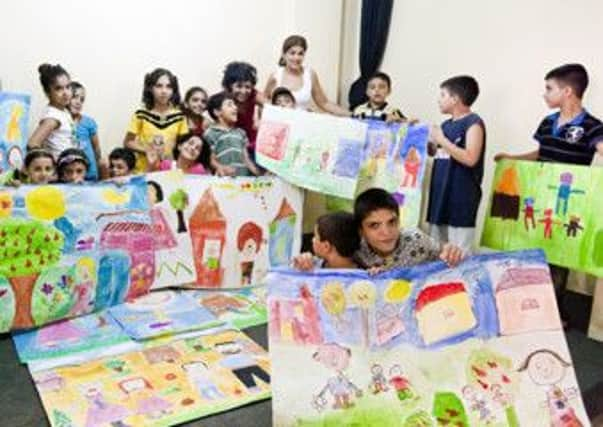Syrian children drawings are brought to Edinburgh


Ramshackle buildings are heaped one on top of the other – with occasional collapses – as space is in short supply. There is little running water, walls are riddled with damp and children play in the narrow, rubbish-strewn alleyways which meander through the camp.
Shatila has existed since 1948 when northern Palestinians fled their homes after the Arab nations’ war with Israel which followed the end of British rule over Palestine and the formation of Israel. Now more than 12,000 of them live in the camp on the outskirts of Lebanese capital Beirut. But in recent years the numbers there have swollen to intolerable levels as the war in Syria has forced a million to flee their country and head into Lebanon.
Advertisement
Hide AdAdvertisement
Hide AdBut even in such appalling conditions, schools are still operating and thanks to humanitarian relief agencies like Najda Now, Syrian refugee children are being given an outlet for their fears and the horrors they have witnessed – through art.
A total of 166 pieces of art produced over three months by primary-aged children living in Shatila will go on display at the City of Edinburgh Methodist Church in Nicolson Square. The pieces may seem bright and cheerful in colour and hue, some almost look inspired by fairy-tales, but closer inspection of others reveals the psychological impact of civil war.
There is blood, there are dead bodies, helicopters, bullets, tanks, soldiers and guns.
According to Brian Devlin of the Children’s War Museum, which along with the Church of Scotland and the Peace and Justice Centre, has been instrumental in bringing the Light Against Darkness exhibition to Edinburgh, Najda Now Lebanon has been giving psychological help to children as the “events in Syria had a negative impact on their minds as well as their physical selves.
“Painting what they saw and how they feel helps them process what they’ve experienced which can help them move on mentally and build resilience in themselves.”
He adds: “Children and teenagers have been forced to leave their homes, under showers of relentless bombardment. Death and destruction has filled their country; raging infernos are destroying their schools and playgrounds; violence, fear and murder have drawn these innocent souls into darkness – the terrifying things they have seen cause deep psychological wounds.
“The support programmes provided by Najda Now can help bring them out of darkness and into light and put smiles back on their sad faces.”
The exhibition has been on display in Beirut and has also travelled to France and Germany, but Brian says, bringing it to the UK has been problematic.
Advertisement
Hide AdAdvertisement
Hide Ad“Raising the money for the transport costs has been an issue and at first we tried to find a venue in London but there was nothing suitable, so Edinburgh was our next option. The churches in Edinburgh have been very supportive, as well as the Edinburgh Peace and Justice Centre.
“It’s all come together and there is a huge amount of interest in the subject matter though and so we are expecting a lot of people will want to see this work, and hear about what is going on in Shatila. We do have faith in that.”
The exhibition will run to November 12 at the City of Edinburgh Methodist Church and Edinburgh University Chaplaincy, with a small selection at St John’s Church, Monday to Friday, 10am to 3pm and at Edinburgh Methodist only Tuesdays 6pm to 8pm and Saturday, November 1 at 10am to 3pm. Admission is free but donations are welcome.
Filling up
THE Syrian civil war has created more than two million refugees, and more than one million of them are now living in Lebanon.
The Palestinian camps in Lebanon, of which there are 12, are now home to a significant number of these new refugees and are swelling beyond their capacities – Shatila now has around 22,000 refugees. Close on 10,000 are from Syria.
The camp, which was established by the Red Cross 66 years ago, became infamous in 1982 during the Lebanese civil war. A Lebanese Christian militia group carried out a massacre killing up to 3500 civilians, in retaliation for the assassination of Lebanese president Bachir Gemayel, wrongly thought to have been carried out by Palestinians. Shatila has been host to refugees from Egypt, Iraq, Jordan, as well as the Kurdish and people from southern Asia.